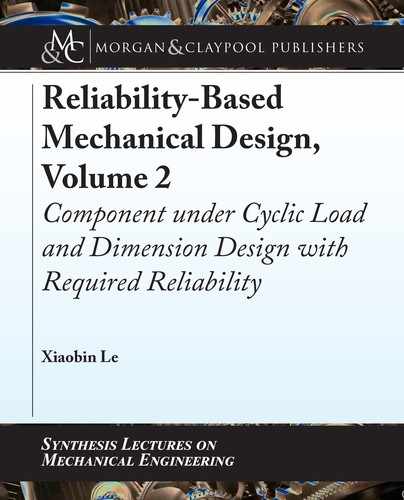
72 2. RELIABILITY OF A COMPONENT UNDER CYCLIC LOAD
Example 2.20
Use the Monte Carlo method to calculate the reliability of the component in Example 2.15 in
Section 2.8.7. A component is subjected to model #5 cyclic loading stresses with three stress
levels as listed in Table 2.32. e component fatigue life at a corresponding cyclic stress level
is also listed in Table 2.32. Use the Monte Carlo method to calculate the reliability of this
component.
Table 2.32: Model #5 cyclic loading spectrum and corresponding component fatigue life for
Example 2.20
Stress
Level
#
Cyclic Stress
Amplitude
Number of Cycles n
Li
(normal distribution)
Component Fatigue Life N
Ci
(normal distribution)
μ
n
Li
σ
n
Li
μ
N
Ci
σ
N
Ci
1 45 (ksi) 11,000 1,200 45,000 3,600
2 40 (ksi) 32,000 5,400 118,800 11,000
3 35 (ksi) 112,000 9,800 356,200 26,000
Solution:
We can use the above Equations (2.70), (2.71), and (2.72) to compile the Monte Carlo method
program. Based on the proposed computational algorithm, the MATLAB program can be com-
piled, and the reliability of the component from the MATLAB program is:
R D
0
@
N
t
X
j D1
tn
j
1
A
=N
t
D
15763743
15998400
D 0:9853:
e result from Example 2.15 by using the equivalent fatigue damage concept is R D
0:9334. e result of the Monte Carlo method is 0.9853. e results are not the same. However,
the relative difference is only 5.6%.
2.9 THE PROBABILISTIC FATIGUE DAMAGE THEORY
(THE K-D MODEL)
2.9.1 INTRODUCTION
For high-cycle fatigue issue, which is the main focus of this book, most of the fatigue test data
are from fatigue tests under a constant cyclic stress level. ere are many theories to interpret
and to describe fatigue data [1, 20]. One of the typical well-known approaches for describing
the fatigue test data is the P-S-N curve approach, which has been discussed in Section 2.8 [3–5].
..................Content has been hidden....................
You can't read the all page of ebook, please click here login for view all page.
